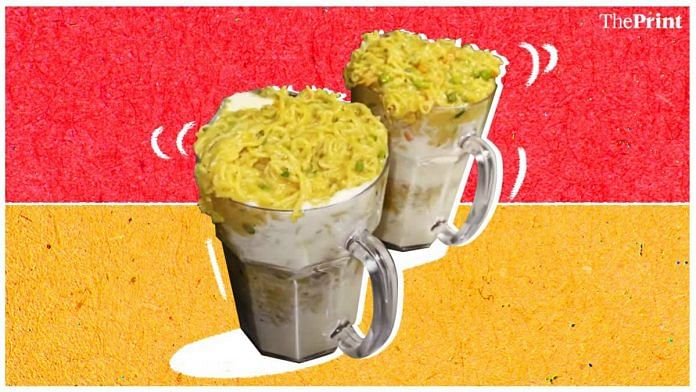Everyone you know is a food puritan — even those who write ‘food lover’ on their Instagram bio and ‘experiment’ every week. There’s always something that will make you crinkle your nose and say, ‘No, that’s taking it too far’. And what better week to test this thesis? In the last couple of days, a lot of ‘cringe food’ showed up on Indian social media. And a Maggi milkshake, took the, er, cake.
It looked just as it sounds — white creamy milk layered with cooked, yellow, soggy Maggi. Tiny bits of orange carrot and green peas topped it off. As Twitter user Angad Singh Chowdhry put it, every day we stray further away from God’s light. Others said, the end of the world is near.
Then there were the Instagram reels of Szechuan pani puri topped with grated cheese, Twitter videos of a barf gola soaked in cream, rabri, chocolate sauce, some green syrup (priced at Rs 999), Fanta omelette and Manchurian samosa. I have even seen cooked Maggi with rasgullah and syrup. And Maggi cooked in milk with a sprinkling of chocolate chips.
@ikaveri Another one from Gujarat, this time it is Surat… What kind of Barf Gola is this🙈🙈🙈 pic.twitter.com/y11cTBKwId
— Mohammed Futurewala (@MFuturewala) September 13, 2021
Yaar 😭😭😭😭 pic.twitter.com/5BeXLyuH5C
— Kamina (@bittu7664) September 11, 2021
If you wish to enjoy the Fanta Omelette head to none other than #Surat #Gujarat
@ikaveri khaas aapke liye hai yeh FANTAstic Omellete😅😅😅 pic.twitter.com/zaUs1xLG9w
— Mohammed Futurewala (@MFuturewala) September 16, 2021
Let’s not forget Delhi’s proclivity to put mayonnaise on almost everything, especially momos. Remember comedian Gaurav Kapoor’s viral video on the fate of sushi if it becomes as popular as momo in Delhi? Gravy sushi, tandoori sushi, malai sushi, chaap sushi.
If we de-construct cringe foods, to use a very Masterchef term, there are two problems that stand out. India, in general, doesn’t get the concept of ‘don’t yuck my yum’, and two, cringe food is as addictive as bad reality TV. As the street food vendor lathers chocolate syrup on biriyani, and the video plays on, you have no option but to watch dazed and disgusted. It’s like Indian Matchmaking, but with foods — you’re unsure, but you are addicted.

Also read: Chai, chaat, chowmein — Indian street food won’t die, neither cholera nor corona can end it
Don’t yuck my yum
Let’s get the heavier dish out of the way.
What makes us dislike funky, excessive, experimental food?
When we were growing up in the 1990s, just after the economic liberalisation, Amul Cheese was becoming widely popular in our fridges. Thirty years later, it’s no more an ‘elite’ European flavour and has reached every street corner conceivable — you now find it on sandwiches, Maggi, dosa, chaat, momos, vada pav, pav bhaji, you name it. To my parents, oodles of cheese being generously grated on chaat probably looks like the Maggi milkshake does to me — ridiculous.
The excess that we cribbed about in American foods — ‘they eat so much carbs and such big plates’ — is now in every street corner. May I introduce you to Bhubaneswar’s ‘Bahubali roll’:
But dig a little deeper, cut out the jokes, remove the garnishing of social media memes, and you’ll find a can of worms. Beyond the ‘excessive’ dishes, we don’t really eat liberally. Why do we gag at certain foods? Why can’t we proudly say ‘don’t yuck my yum’, and don’t knock it till you try it?
Scientifically, the gag reflex in human beings is both somatogenic (physical direct trigger) and psychogenic (mental trigger).
And we Indians have a lot of psychogenic triggers — we are pretty rigid when it comes to food we cherish, rarely crossing caste, religion, regional, or economic lines. And don’t throw the biriyani argument at me. It’s an exception, not the rule. For instance, how many of us have eaten rakti (a dish cooked from coagulated blood), or fish tenga from Assam, or can even name ‘South Indian’ dishes beyond dosa, idli and sambar? Can you stand the smell of axone, the Naga fermented soybean at the centre of a Netflix film of the same name? Truth is, we experiment very little. Even the most liberal is a conservative when it comes to dishes they like — you don’t like anyone messing with your biriyani, rajma, or chicken curry. Novelist Jonathan Safran Foer once wrote, “Food is not rational. Food is culture, habit, craving and identity.”
(Sometimes, we go a little beyond, and don’t let others eat what we don’t like too, but that’s for another day.)
Experimenting doesn’t mean trying something ‘exotic’ — it means just testing your boundary a bit, and not crinkling your nose when your partner gobbles down the last of the mayo momos that you so detest.
Have you drunk coffee and tea together? My mother remembers it being served on the trains to Chennai decades ago — it was called ‘Chafee’ then. That’s an experiment all of us can do in our kitchens this evening.
Or what about Kolkata’s famous Doodh Cola from Balwant Singh’s Eating House?
Also read: 4am Dairy Milk, dancing prawns, langar — what coronavirus did to how we eat
Cringe TV
Now for dessert.
No matter what you think of it, no matter how justifiably detestable the food is to you, if you saw the Maggi milkshake, you most likely forwarded it — purely for its shock value. Or you watched the chocolate sauce being drizzled on the biriyani. Because cringe food is as good/bad as cringe TV. In an age of reels, fast videos and Buzzfeed Tasty, we consume food content more than ever. A Mukbang video — where people basically just eat food in front of a camera for YouTube — gets millions of views. Take this one, for instance — it comes with good ASMR, which means you get to hear the sound of the host eating as clear as water. It has 54 million views and counting.
So why do we watch it? Or even the roadside sandwich being made with heaps of bhujia on top? By the way, Indian street food videos also have millions of views.
My theory is that there are two reasons. One, we are vicariously living through them, we are seeing people eat and make something we never will. Second, our brains are too exhausted (The Great Burnout) to process something that we need to invest in — it’s a common phenomenon many of my friends talk about. Being too tired to pick a movie, and ending up watching something mindlessly. I have watched dozens of Korean food videos while chatting on WhatsApp — it’s not recommended. And food satisfies us — not just physically, but mentally too.
It’s like watching Keeping Up With The Kardashians, or a random video that happens to pop up on our Facebook timeline. Doesn’t really matter if it’s good or bad. Cringe food is the Roadies of the internet. We’ll watch it, but will we do it ourselves? No.
And no, I have not eaten Maggi milkshake before my sermon on cringe food. But if it makes you feel better, I often have uncooked Wai Wai noodles, broken and mixed with the flavourings, as a snack.
Views are personal.
(Edited by Prashant)



